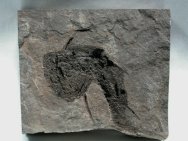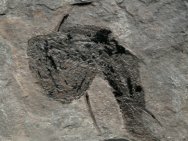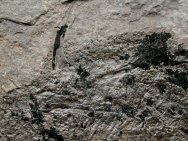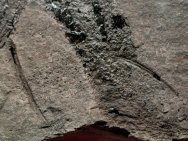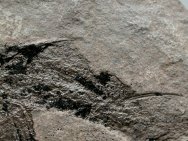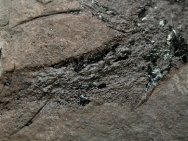Cheiracanthus
sp
Class Acanthodii,
Order Acanthodiformes
Geological
Time: Lower Devonian (375 Million years
ago)
Size (25.4mm=1
inch): 85 mm in length on 100 mm by 83 mm matrix
Fossil Site:
Achanarras Slate Quarry, Old Red Sandstone, Caithness, Scotland
| 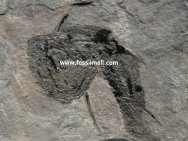 Description:
The Acanthodians are jaw-bearing fish who still are the subject
of dispute over their systematic position. They possess highly advanced,
spindle-shaped bodies thought to have made them swift swimmers.
The body was covered in small mosaic-like scales. They possessed
small teeth that were typically confined to the lower jaw; some
were toothless. The feature they all share in common is the fact
that massive spines formed of dentine support all fins other than
the caudal fins. Indeed, the name Acanthodii is derived from the
Greek word for spine. The oldest acanthodian lived during the late
Ordovicain. They reached their peak during the Devonian, and became
extinct during the Great Dying of the end-Permian extinction. This
well-preserved example is known as Cheiracanthus; the genus died
out in the upper Devonian. As is typical, the most prominent feature
to be seen here are the diagnostic spines. This has some distortion
to the anterior due to post-mortem bloating. Description:
The Acanthodians are jaw-bearing fish who still are the subject
of dispute over their systematic position. They possess highly advanced,
spindle-shaped bodies thought to have made them swift swimmers.
The body was covered in small mosaic-like scales. They possessed
small teeth that were typically confined to the lower jaw; some
were toothless. The feature they all share in common is the fact
that massive spines formed of dentine support all fins other than
the caudal fins. Indeed, the name Acanthodii is derived from the
Greek word for spine. The oldest acanthodian lived during the late
Ordovicain. They reached their peak during the Devonian, and became
extinct during the Great Dying of the end-Permian extinction. This
well-preserved example is known as Cheiracanthus; the genus died
out in the upper Devonian. As is typical, the most prominent feature
to be seen here are the diagnostic spines. This has some distortion
to the anterior due to post-mortem bloating.
|
|

